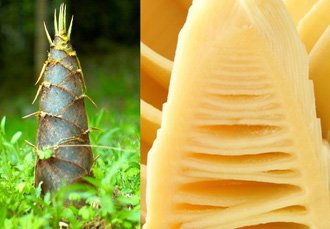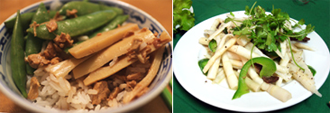Bamboo Shoots Nutrition facts
Crisp and chewy bamboo shoots, known as "sun jian" (笋尖), are the newly sprouted edible stems of bamboo plants. These young, tender shoots are highly prized as a seasonal delicacy in China, Taiwan, Japan, and various Southeast Asian nations. Multiple species of bamboo are cultivated specifically for bamboo shoot production.
 |
| Tender bamboo shoots. (Photo courtesy: Joi) |
The bamboo plant, belonging to the grass family, produces edible shoots typically after 3-4 years. These shoots emerge from the root system and are harvested for consumption. Among the notable edible species are Bambusa bambos, Bambusa tulda, B. polymorpha, B. balcooa, Dendrocalamus hemiltonii, D. gigentius, and Melocanna baccifera.
The appearance of bamboo shoots above ground varies depending on the species and season. When a young shoot emerges, resembling a cone shape above the soil, it is cut from its root using a spade.
Encased in several layers of leaves, the shoot contains a prized creamy-white core, known for its crunchy texture and mild, distinctive flavor. Once boiled and processed, the flavor becomes almost neutral.
Health benefits of Bamboo Shoots
Bamboo shoots are exceptionally low in calories, with just 27 calories per 100 grams of fresh cane.
Bamboo hearts contain moderate levels of soluble and non-soluble dietary fiber, providing 2.2 grams of roughage per 100 grams of fresh shoots. This fiber aids in managing constipation and reducing LDL cholesterol levels by binding to it in the intestines.
Research indicates that a diet rich in fiber may lower the risk of colon-rectal cancer by shielding digestive organs from harmful compounds in food.
Bamboo hearts are also abundant in B-complex vitamins such as thiamin, riboflavin, niacin, vitamin B-6, and pantothenic acid, essential for optimal cellular and metabolic functions.
Bamboo is rich in minerals, particularly manganese and copper, with small amounts of calcium, iron, and phosphorus. Manganese acts as a co-factor for the antioxidant enzyme superoxide dismutase, while copper is crucial for red blood cell production and iron for cellular respiration and red blood cell formation.
Bamboo shoots are an excellent source of potassium, providing 533 mg or 11% of the daily required intake per 100 grams. Potassium plays a vital role in regulating heart rate and blood pressure by counteracting the effects of sodium.
| Principle | Nutrient Value | Percent of RDA |
|---|---|---|
| Energy | 27 Kcal | 1.4% |
| Carbohydrates | 5.2 g | 4% |
| Protein | 2.60 g | 5% |
| Total Fat | 0.3 g | 1% |
| Cholesterol | 0 mg | 0% |
| Dietary Fiber | 2.2 g | 6% |
| Vitamins | ||
| Folates | 7 µg | 2% |
| Niacin | 0.600 mg | 4% |
| Pantothenic acid | 0.161 mg | 3% |
| Pyridoxine | 0.240 mg | 18% |
| Riboflavin | 0.070 mg | 5% |
| Thiamin | 0.150 mg | 12% |
| Vitamin C | 4 mg | 7% |
| Vitamin A | 20 IU | <1% |
| Vitamin E | 1 mg | 7% |
| Vitamin K | 0 µg | 0% |
| Electrolytes | ||
| Sodium | 4 mg | <1% |
| Potassium | 533 mg | 11% |
| Minerals | ||
| Calcium | 13 mg | 1.5% |
| Copper | 0.190 mg | 21% |
| Iron | 0.50 mg | 6% |
| Magnesium | 3 mg | <1% |
| Manganese | 0.262 mg | 11% |
| Phosphorus | 59 mg | 8% |
| Selenium | 0.8 µg | 1.5% |
| Zinc | 1.10 mg | 10% |
| Phyto-nutrients | ||
| Carotene-ß | 12 µg | |
| Carotene-a | 0 µg | |
| Lutein-zeaxanthin | 0 µg |
Selection and storage
Bamboo shoots, a seasonal delicacy, are highly sought after. In the USA, fresh shoots, particularly frozen ones, are imported from China, Thailand, and Taiwan. However, vacuum-packed or canned bamboo shoots are available year-round in supermarkets.
When purchasing fresh shoots, opt for recently harvested ones. Look for firm and heavy sprouts with a broad base, avoiding those with soft, dry roots. Examine the base closely for any greenish discoloration, which indicates overexposure to sunlight, overripeness, and a potential bitter taste.
For optimal flavor, fresh bamboo shoots should be consumed shortly after harvest. Alternatively, to preserve freshness, store the unpeeled shoot wrapped in a paper towel in the refrigerator, where it can last for 1-2 days.
Preparation and serving methods
To prepare raw bamboo shoots from the market for cooking, it is essential to undergo a two-step process: removing their tough outer sheaths and detoxifying their inner meat to eliminate bitter compounds. One convenient method for peeling bamboo shoots is to halve them lengthwise, then carefully peel away the outer leaves from the base to the tip. Trim any tough portions at the base and dice the shoots to your preferred size. To prevent discoloration, soak the cubes in cold water.
Detoxifying the processed cubes involves boiling them. Bamboo shoots contain taxiphyllin, a cyanogenic glycoside that must be eliminated before cooking. Boil the cubes in an uncovered pot of salted water for approximately 20-25 minutes to remove most of these glycosides. Discard this water and boil the shoots again in fresh water for an additional 5-10 minutes to ensure complete safety.
Here are some serving tips:
 |
| Bamboo shoot ricipes. (Photo courtesy: tuey & elsie-hui) |
- Sautéed, stir-fried, or combined with vegetables, beans, poultry, or seafood, bamboo shoots offer versatile culinary options.
- In Thailand, Laos, and Vietnam, bamboo shoots are esteemed seasonal delicacies, featuring in a variety of mouth-watering recipes prepared using traditional methods.
- In Thailand, sour bamboo shoot pickle, known as a delicacy, is utilized in flavorful curries alongside vegetables and shrimp, served with steamed rice.
- In China, tender bamboo shoots are commonly incorporated into soups, noodles, salads, and stir-fries.
- Known as takenoko (竹の子) in Japan, bamboo shoots are celebrated as spring specials. They are finely sliced and added to salads, stir-fries, or rice dishes (takenoko gohan).
Safety profile
Generally, boiled bamboo shoots are considered safe for consumption, and allergic reactions are rare. Bamboo shoots contain taxiphyllin, a cyanogenic glycoside that can inhibit cytochrome oxidase, a crucial enzyme in cellular respiration. Overripe shoots and specific bamboo varieties may have higher concentrations of these glycosides compared to young, tender, and sweeter varieties. Boiling the tender shoots effectively breaks down these toxic compounds. See the (Medical disclaimer) for more information.
≻≻-Back to Vegetables from Bamboo Shoots. Visit here for an impressive list of vegetables with complete illustrations of their nutrition facts and health benefits.
≻≻-Back to Home page.
Further Reading:
www.foodstandards.gov.au- Cyanogenic glycosides in cassava and Bamboo-A human Risk Assessment.